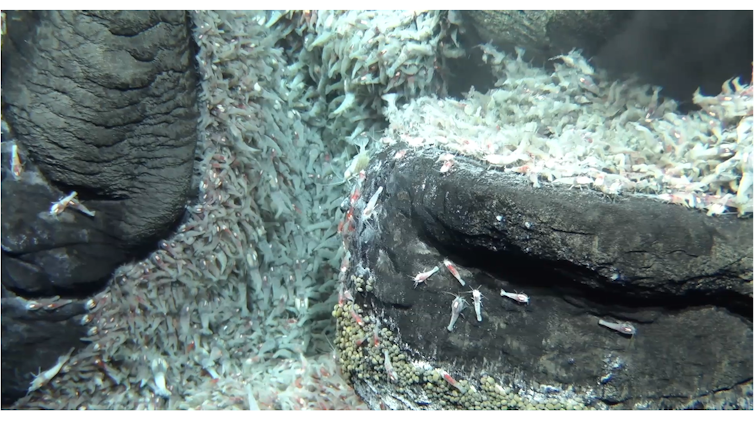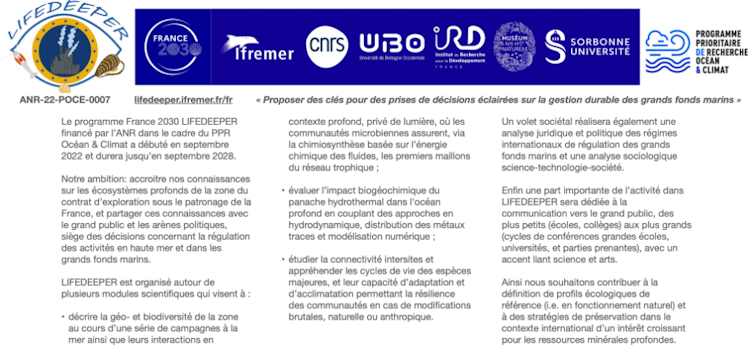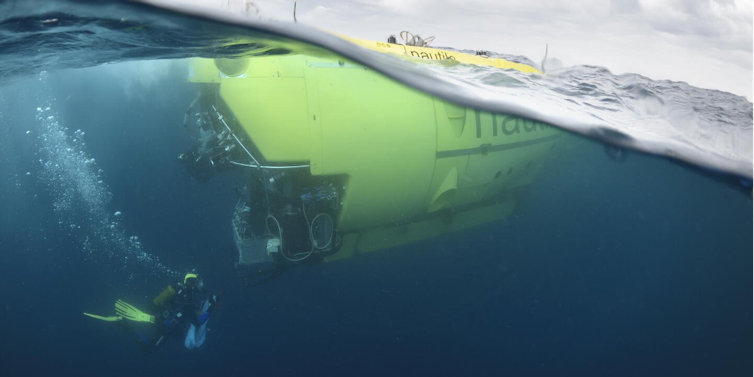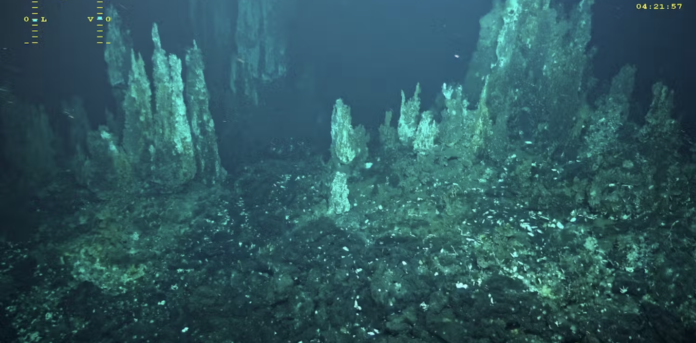At a time when many countries would like to make the mining of the abysses of our oceans possible, scientists are calling for caution and the need to better understand the biodiversity of the deep seabed, which is still so mysterious in many respects.
It is a race against time which opposes two temporalities: on the one hand that of science, which is working hard to better understand the ecosystems of the deep seabed, which is still very incomplete. On the other side, that of prospective appetite and mining law in international waters, on which the International Seabed Authority is working (AIFM), UN agency of 168 members. For more than ten years, this authority has been working on a text which, if adopted, would authorize the mining of the seabed.
France’s positionannounced by the President of the Republic at the United Nations Ocean Conference in 2022, and since joined by several countries including Canada and Vanuatu, is in favor of a moratorium prohibiting the exploitation of deep mineral resources due to fault sufficient knowledge about the diversity and functioning of ecosystems. But other countries such as Norway, the United States or the small island of Nauru, on the contrary, advocate the rapid adoption of the mining code in order to be able to launch commercial exploitation within 1 or 2 years. Extraction tests have even already been carried out by the Nautilus Minerals group in the Manus basin, then abandoned following the establishment of a moratorium in its EEZ by Papua New Guinea. Manufacturers believe that these resources are essential to access a decarbonized (for example for building wind turbines) and digitalized (for example for the manufacture of our connected objects) global economy.
Ifremer according to AIFM, Provided by the author
Hydrothermal vents and massive sulfide deposits
Massive sulphide deposits constitute one of the three resources targeted with polymetallic nodules and cobalt-bearing crusts. These resources are located between 1,000 and 5,000 m depth in all oceans but at precise and dispersed points. If crusts are found on the walls of seamounts and nodules on the surface of certain abyssal plains, metal-rich sulphides come from hydrothermal activity associated with oceanic ridges and back-arc basins.
At an active hydrothermal site, seawater penetrates the oceanic crust and emerges in the form of geysers — black smokers — rich in polymetallic sulfides which precipitate on contact with cold water from the ocean floor. Chimneys are then formed, a sort of stalagmite which can reach several tens of meters high. These hydrothermal vents are home to exuberant fauna that feed on bacteria capable of using these particular mineral resources to produce organic matter.

Ifremer BICOSE2 campaign, Provided by the author
But the target of the miners would rather be the massive deposits of sulphides that these chimneys generate by aggregating over time and which persist long after the sources dry up. For miners – and politicians – things are simple: an active site would be unexploitable but an inactive site – devoid of wildlife – would be exploitable. For scientists, it’s a little more complex. Fields of inactive chimneys can indeed be present in the axial valley of oceanic ridges but these deposits, limited in volume, are often mixed with active sites on fast ridges — where the tectonic plates move apart by more than 10cm /year as in the Eastern Pacific.
Inactive sites? Really ?
In this case, the mining of these areas is likely to lead to a drying up of the sources still present in the area or to reactivate certain inactive deposits by modifying the hydrothermal circulation in the sub-surface. The reopening of old blocked conduits has already been demonstrated following samples of fauna or rocks from apparently inactive deposits. However, most ancient massive hydrothermal deposits are found outside the axis of the ridges due to the movement of tectonic plates, which makes their location very difficult in the absence of chemical anomalies in the water column.
The very notion of an inactive site is in fact widely debated. Around the fast East Pacific Ridge, a recent study showed that, on these inactive sites lacking the exuberant fauna of active sites, a significant microbial activity persists and generates significant local primary production. Even on the Atlantic ridge, which is slower (around 1 cm/year), we have also demonstrated during a series of campaigns in the French exploration contract area that certain sites supposedly inactive and described as such, are in fact of the low temperature sites harboring specific bacteria and fauna. Exploration of this area has continued since 2014 with campaigns with both geological objectives (HERMINE campaigns) than biological (BICOSE campaigns) and in particular in the context of LIFEDEEPER program (see box). Ultimately, the results acquired will constitute a reference state on the distribution of sites and the functioning of these different ecosystems.

Provided by the author
Ecological connectivity, key data for assessing the consequences of a disturbance
To assess the impact area of a disturbance, particularly in the face of possible mining, an essential element is to know the life cycle and dispersal capacities of the major species of these ecosystems. We can then assess their resilience and their capacity to recolonize the environment following these disturbances.
But sampling all the life stages of a given species — eggs, larvae, juveniles, adults — is an objective rarely achieved in deep environments given the thickness of the water column to be explored. Fortunately, there are indirect methods based on the genetics of populations of adults and/or young recruits observed on different sites, or on the study of chemical fingerprints “recorded” in the larval shell of bivalves or gastropods, which allow to reconstruct their dispersal history and identify their birth site.
The studies of population connectivity of the same species, and by extension communities of species dependent on deep hydrothermalism are particularly promising for defining the zones at the origin of exchanges (source populations) and the zones which are content to receive the larvae emitted the outcome of their journey in the water column (sink populations). However, depending on the geological context of the ridge, these exchange dynamics can prove more complex over time when sources become sinks and vice versa. To assess the degree of exchanges between communities, a hierarchical collection of wildlife over large geographic distances (often determined by the species’ distribution area) is necessary.
In the particular case of the French exploration contract area, it is therefore important to extend this study of the hydrothermal fauna along the mid-Atlantic ridge well beyond and on both sides of it. to better appreciate its importance on the resilience of hydrothermal communities on a regional scale. As such, population genetics studies based on the genomes of several Atlantic hydrothermal species during the H2020 European project iAtlantic showed that the portion of the ridge located between the Snake Pit sites (23°N off the coast of the West Indies) and Rainbow (35°N close to the Azores archipelago) could constitute a zone of less migration where populations of geographically distant species meet occasionally and hybridize locally.
Preserve hydrothermal species
This disruption or attenuation of hydrothermal connectivity poses a problem for the preservation of communities associated with a mining resource under moratorium, the destruction of hydrothermal habitats potentially increasing the isolation of neighboring populations and reducing the genetic diversity of species. The study of populations of hydrothermal species along the ridge is peaceful (BIOSPEEDO campaign 2004) then in the back-arc basins of the Western Pacific (CHUBACARC campaign 2019) also allows us to draw certain lessons on the dynamics of exchanges and the degree of resilience of communities subservient to this particular environment.
The first lesson is that hydrothermal species are much more geographically structured than previously thought (hypothesis according to which these species are capable of dispersing over long periods of time to compensate for the natural instability of their habitat). The connectivity of architect species (forming habitat for other species) is often extremely limited spatially by major geotectonic discontinuities such as microplates, transform faults or subduction arcs. These physical barriers to dispersal tend to generate a multitude of geographical species which can only exchange very little with each other, which considerably limits any rescue effect of one population by another on a regional scale. .
The second lesson is that current hydrothermal communities are composed of a multitude of species with very different life history traits, with some species being able to disperse long and far while others can only disperse closely. As most species are interdependent to ensure the proper functioning of the ecosystem as a whole, an approach to population connectivity must necessarily be multi-species to be able to make appropriate recommendations on the spaces to be protected and the sustainable management of these communities. .

Ifremer, Olivier DUGORNAY, Provided by the author
And now ?
In accordance with its positions on the moratorium for the exploitation of deep-sea mineral resources, France devotes one of the 10 objectives of the “France 2030” plan to the development of solutions enabling to accelerate the acquisition of knowledge on the deep seabed. It is in this context that the PEPR GFM has just been launched. There is urgency because the international context around these issues is important. However, with the range of means already available to the French oceanographic fleet for the exploration of the GFM and the extent of its EEZ distributed throughout the oceans, French research has solid assets to advance our knowledge of these underwater “terra incognita” thanks to future underwater exploration expeditions. navy. Provided, however, that the human potential capable of carrying out these complex investigations is maintained…

This article is published as part of the Science Festival (which takes place from October 4 to 14, 2024), and of which The Conversation France is a partner. This new edition focuses on the theme “ocean of knowledge”. Find all the events in your region on the site Fetedelascience.fr.

